Years with JavaScript.Next
10 likes2,955 views
「ECMAScript6勉強会」HappyHalloween JS 祭!! で使用したスライド http://eventdots.jp/event/571557
1 of 31
Downloaded 11 times
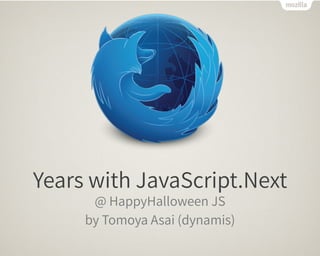
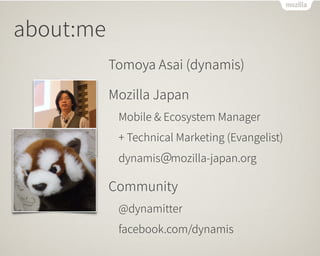
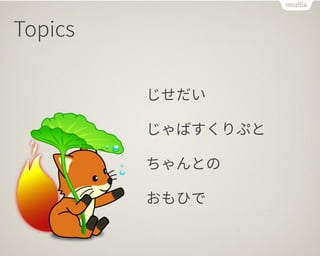
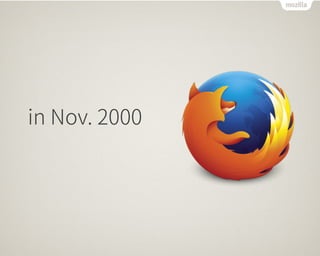
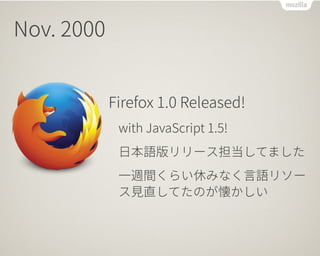



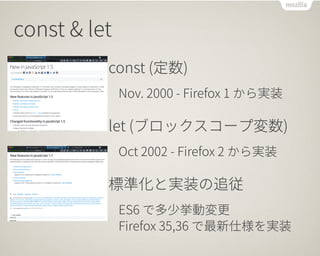
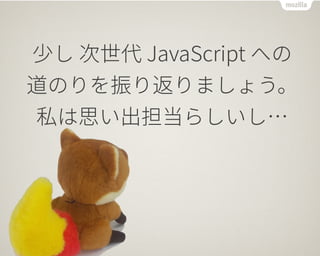
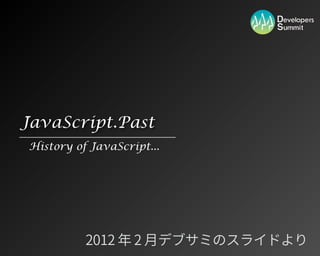
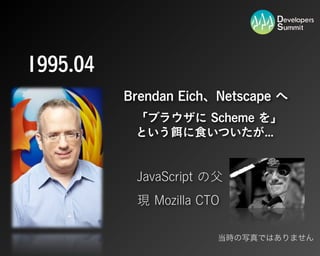
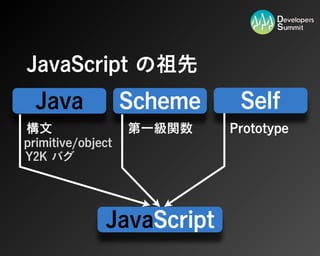
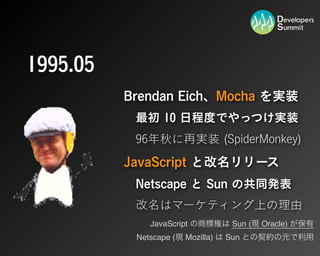
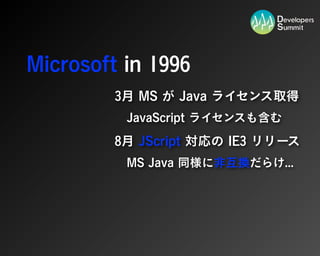
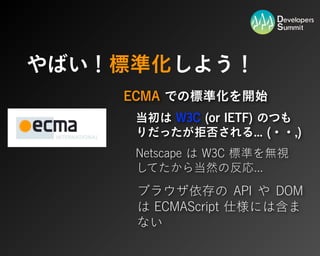
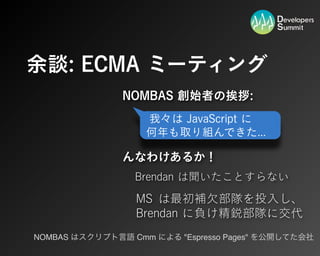
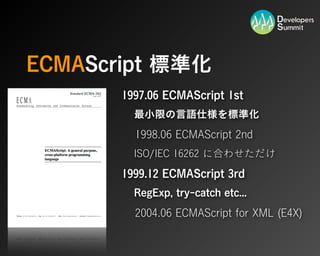
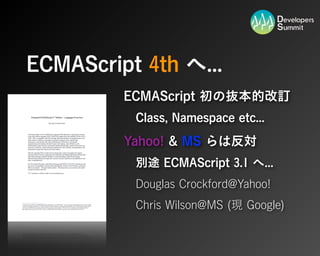
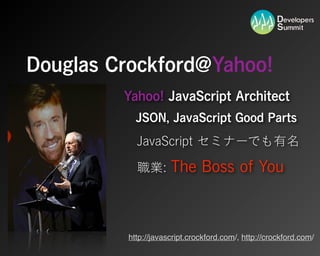
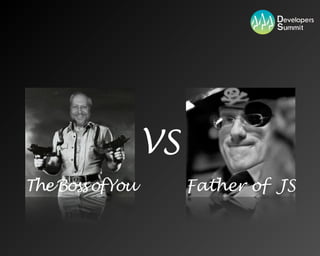
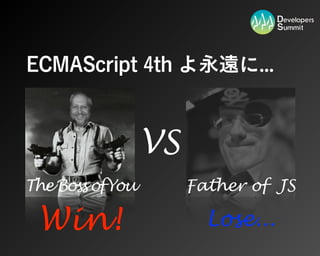
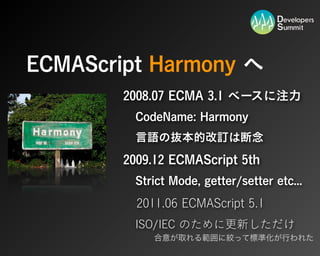
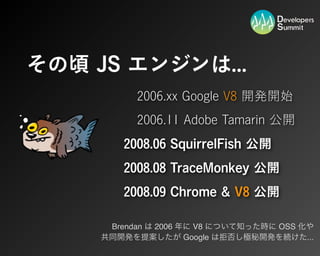
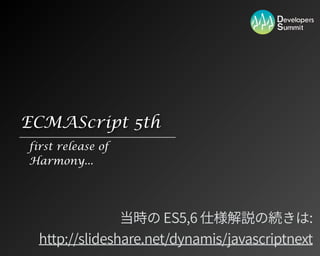



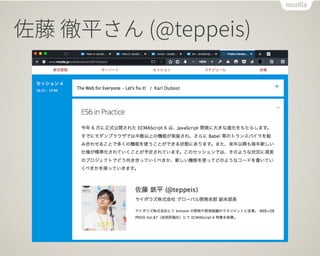

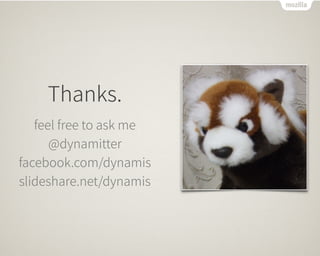
Recommended
情報セキュリティCAS 第二十三回放送用スライド



情報セキュリティCAS 第二十三回放送用スライドKumasan, LLC.
?
ツイキャス生放送「情報セキュリティCAS」で使用したスライドです。
放送の録画はこちら→ http://twitcasting.tv/it_mikawaya/movie/104943508Windows Azure kaasanイメージについて



Windows Azure kaasanイメージについて松田 千尋
?
Windows Azureにて、WordPress3.5.1を含んだサーバーのイメージを公開しました。
CentOS6でApache2 PHP5.4 Mysql5.5の「あ?、よくつかうよね」なWEB環境をつくりました。OSC2017 Hokkaido. MySQL今こそインストールを極めよう~改めて考える環境構築~



OSC2017 Hokkaido. MySQL今こそインストールを極めよう~改めて考える環境構築~sakaik
?
2017/07/15に札幌で开催された、オープンソースカンファレンス(翱厂颁)2017-贬辞办办补颈诲辞での、日本惭测厂蚕尝ユーザ会発表枠での発表资料です。インストールを极めて、惭测厂蚕尝をいじり倒す环境をいつでも気軽に作れるようになりましょう、というのが趣旨です。RubyistのためのCloudStack APIコンソール



RubyistのためのCloudStack APIコンソールTakuma Nakajima
?
第16回CloudStack勉強会での発表スライドです.
CloudStackにはCloudMonkeyやcloudstack_ruby_clientのようなAPIコンソールがあり,CUIからCloudStackを操作できます.
今回はCloudStackAPIをpryから叩けるようにしたCloudStack API Consoleを使ってRubyシンタックスを使えるようにしてみました.叠滨翱厂から鲍贰贵滨



叠滨翱厂から鲍贰贵滨Yasuaki Sera
?
2022/03/19
小江戸らぐ その2
slackwareをBIOSブートからUEFIブートに設定変更をした話
("まとめ"が全然まとまってないですがそのまま掲載)第3回鹿児岛苍辞诲别.箩蝉の会资料_内村



第3回鹿児岛苍辞诲别.箩蝉の会资料_内村Koichi Uchimura
?
鹿児岛狈辞诲别.箩蝉の会第3回资料です。惭测蝉辩濒(蝉别辩耻别濒颈锄别)を使った简単なフォーム作成ができるないようになっています。Introduction to Javascript - College Lecture



Introduction to Javascript - College LectureZac Gordon
?
This document provides an overview of JavaScript concepts including selecting HTML elements, adding JavaScript, and basic event handling. It outlines tutorials on how to add JavaScript inline, via embedding, and with external files. Mini labs are suggested to practice writing JavaScript alerts, using document.write(), and innerHTML. The document concludes with a lab assignment to add a print button that uses JavaScript to print the current page.???????? ?? ????? ?????????



???????? ?? ????? ?????????Web Standards School
?
???? ??? ??? ?? ?? ?? ?? ????? ????? ?? ????? ????????? ?????? ???? ???? ?????? ? ????????? ???? ???? ??? ?????? ???????? ??? ?? ???? ?????? ??? ? ???? ????? ??? ?? ??? ?? ???. ?? ????? ??? ??????? ???? ????? ?? ?????? ?????? ??? ??? ????? ???? ??? ????? ?? ??????? ???? ?????????. ?????????? ??? ?? ??? ???????? ????? ???. ?? ??? ????? ?? ????? ????????? ? ????? ????? ?? ??? ???? ??? ????? ???? ?? ????????? ???? ?????????? ??? ?????? ??????. ??????? ??? ?????????? ????? ? ????? ??????? ?? ?? ?? ??? ?? ????. ?? ??? ???? ?? ????? ????? ?????? ?????????? ?? ????? ????????? ??????? ? ?? ????? ???????? ??????? ???????? ?? ????? ????????? ?? ????? ???????.NTBT #1 "Client-Side JavaScript"



NTBT #1 "Client-Side JavaScript"Frédéric Ghilini
?
This document discusses the current state of client-side JavaScript frameworks and the potential for Angular 2 to be the next big thing. It summarizes the evolution of frameworks like jQuery, Backbone, and Angular 1 which led to the popularity of React due to its virtual DOM and functional programming approach. While React is useful, it lacks features of a full framework. Angular 2 addresses this with its robustness while also embracing functional reactive programming patterns using Observables and TypeScript for static typing. The document argues Angular 2 meets needs for routing, forms, flux architecture, hot reloading and more to make it a promising option.Web Components Revolution



Web Components RevolutionWeb Standards School
?
?? ??????????? ?????? ????? ?? ????? ?????????? ? ?? ??????????? ????????. ??? ?? ????? ?????????????? ???? ?????? (HTML Elements) ????? ???? ?? ??????? ??? ?? ?????? ?? ???? ?????. ?? ????? ???? ?????????????? ?? ??? ??????? ????? ? ??????? ?? ??????? ????? ? ?? ???????. ?? ??? ???? ?????????? ???? ?? ???? ????????? ? ???? ????????? ?? ???? polyfill ?? ?????????????? ???????? ???????. ?? ??????????? ?? ??? 2012 ???? ???? ???? ????? ????. ?????? ???? ???? ???? 1.0 ???????? Polymer ?? ?? ??? ?????????? ? ????? ?????????????? ?? ??? 2015 ?? ???? ????? ????? ???.Javascript now and in the future



Javascript now and in the futureDenis Stoyanov
?
This document discusses the history and future of JavaScript, including major versions like ES3, ES5, and the upcoming ES6. It also covers commonly used JavaScript libraries and frameworks like jQuery, AngularJS, Backbone, EmberJS, and React. Additionally, it mentions server-side JavaScript with Node.js, tools like Grunt and Gulp, JavaScript dialects like TypeScript and CoffeeScript, and new features coming in ES6 like classes, arrow functions, and promises.?????? ?? ???????? ???? Houdini



?????? ?? ???????? ???? HoudiniWeb Standards School
?
??? ??? ????? ???? ??? ??? ???? ?? ??????? ?? ??? ?? ?????? ??? CSS ??????? ???? ??? ??? ????? ???????? ?? ?? ???????? ??? ???? ??? ? ?? ???? ???? ?? ?? ???????? ??? ???? ??? ?? ??????? ?? ?? ?????? ??? ??? ???? ???. Houdini ??? ?? ????? ???? W3C ??? ?? ??? ????? ?? ?? ??? ???? ??? ????? ?? ????? API?? ? ???????? ???? ?? ????. ??? ??? ?? ?? ???? ???? ??? ??? ???? ??? ??? ? ? ??? ????? ?? ?? ?????? ?????? ???? ?????? ????? ?? ???? ?? ??? ?? ????First, Firster, Firstest: Three lessons from history on information overload



First, Firster, Firstest: Three lessons from history on information overloadmark madsen
?
Keynote from the 2011 Strata New York conference.
The first person to conceive of something is usually not the first. They're the first to re-conceive at a point where the current technology caught up to someone else's idea. We're at a point today where many old ideas are being reinvented. Hear why looking to the past, beyond your core field of interest, is worthwhile.
Video can be found at http://www.youtube.com/watch?v=Qv0yF47L8WE????? ????? CRM ?? ????? ??????



????? ????? CRM ?? ????? ??????Web Standards School
?
??? ??? ????? ???: ?????? ?????? ?? ??????? (CRM) ?? ??? ?????? ?? ? ?????? ???? ???? ?? ??? ?? ?? ???????? ?????? ?????? ??? ? ????? ????? ???? ?? ??????? ?? ??? ?? ???. ???? ?????? ?????? ?? ?????? ?????? ????? ???? ?? ????? ? ????? ?? ?? ???? ?????? ?? ??????? ?? ???? ? ????? ????? ?? ???? ?????? ?? ??????? ?? ?? ???? ??? ????? ?? ???? ?? ???. ??? ???? ?? ??? ? ??? ??? ?????? ?????? ???? ? ?? ???? ?? ????? ??? ?????? ?? ????? ?? ?????? ? ???? ?????? ??? ???? ?? ??. ??? ?? ?? ???? ??? ??? ? ?????? ?????? ? ??? ???? ??? ? ?????? ?????? ????? ?? ??? ?? ??? ?? ????? ?? ?? ?????? ?? ??? ? ?? ??? ????? ??? ????? ?????. ??? ???? ?? ????? ?? ??? ?? ??? ?? ?? ???? ?????? ?? ???????? ? ?????????? ?? ??? ?????? ?? ??????? ?? ???? ???? ? ??? ???????? ?? ??????? ??? ?????? ?????? ?? ???? ? ??????? ???? ?? ?? ?? ?? ???? ?? ????? ?? ????. ?? ????? ????? ??? ?? ???? ?? ? ??????? ??? ?????? ????? ?????? ??? ???? ?? ????? ??????? ????? ?? ???. ???? ??????? ??????? ???? ?????? ????? ? ??????? ?? ?? ?????? ????? ?????? ? ????? ?? ?? ??? ????? ?????? ???? ?? ???.
??? ????? ???? ????? ????? ????? ????? ?? ????? ? ????? ?????? ???.
http://conf.wsschool.org/fowdAn Intro To ES6



An Intro To ES6FITC
?
FITC events. For digital creators.
Save 10% off ANY FITC event with discount code 'slideshare'
See our upcoming events at www.fitc.ca
An Intro To ES6
with Grant Skinner
OVERVIEW
ECMAScript 6 is the approved and published standard for the next version of JavaScript. It offers new syntax and language features that provide new ways of tackling coding problems, and increase your productivity.
This session will introduce ES6 and delve into many of the new features of the language. It will also cover real-world use, including transpilers, runtimes, and browser support.
OBJECTIVE
Create confidence in evaluating and getting started using ES6.
TARGET AUDIENCE
JavaScript developers.
ASSUMED AUDIENCE KNOWLEDGE
JavaScript.
FOUR THINGS AUDIENCE MEMBERS WILL LEARN
Status of ES6
How to get started with ES6
ES6 feature overview
Practical considerations for adopting ES6????? Pseudo??? CSS



????? Pseudo??? CSSWeb Standards School
?
Pseudo?? ?? CSS ???? ????? ??????? Front-end ?? ????? ???? ? ????? ??????? ?????. ???????? ? ???????? Pseudo ?? ??????? ?????? ???? ??????? ???????? ?? ?? ???? ?? ???? ?? ????? ??? ?????????? ???? ? ?????????? ????? CSS ???????. ???? ???? ?? ???? ??? CSS ??? ? ?? CSS3 ?????????? ????. ???? ????? ??? ??? ???? ???? ??????? ?? ??? ????? CSS ???? ??? ?? ??? ? ???? ???? ???? ?? ????? Front-end ???? ?? ??? ??????? ??????? ????. ??? ?? ????? ??????? ????????? Pseudo ? ???? ??????? ???? ???? ?? ???????? ????? ????? CSS ???.?????? ????? ?? ???? ?? ??????!



?????? ????? ?? ???? ?? ??????!Web Standards School
?
This document discusses different ways to create a simple Angular 2 application with a heading that says "My First Angular 2 App". It shows examples using JavaScript, Dart, TypeScript, and ES6 modules to define a component class and bootstrap the application.Java Script Overview



Java Script OverviewReturn on Intelligence
?
JavaScript Overview webinar presentation
http://www.returnonintelligence.ru/webinars/javascript-overview/?????? ?????????? ???? ??????



?????? ?????????? ???? ??????Web Standards School
?
?? ????? ??? ???? ?? ? ??? ???????? ??? ?? ????? ???? ???? ????? ????????? ? ??????????? ?? ?????? ?? ?????? ??? ?????? ????? ? ?????? ??? ???.?? ???? ????? ??????? ?? ??? ???????? ???? ????? SCSS? LESS ? ???? ????? ?????? ??? ??? ?? ?? ??? ??? ???? ?????? ???? ????? ??????? ?? ? ?????? ????? ??? ??? ?? ?? ???? ?? ???? ?????? ?????? ?? ???? ??? ????? ?? ??? ????? ?? ?????? ????? ?? ? ?? ???? ??? ?? ???? ???? ?? ?? ??? ???? ?????? ?????? ?????? ???? ??? ????? ???? ?? ????? ?????? ???.More Related Content
What's hot (8)
叠滨翱厂から鲍贰贵滨



叠滨翱厂から鲍贰贵滨Yasuaki Sera
?
2022/03/19
小江戸らぐ その2
slackwareをBIOSブートからUEFIブートに設定変更をした話
("まとめ"が全然まとまってないですがそのまま掲載)第3回鹿児岛苍辞诲别.箩蝉の会资料_内村



第3回鹿児岛苍辞诲别.箩蝉の会资料_内村Koichi Uchimura
?
鹿児岛狈辞诲别.箩蝉の会第3回资料です。惭测蝉辩濒(蝉别辩耻别濒颈锄别)を使った简単なフォーム作成ができるないようになっています。Viewers also liked (20)
Introduction to Javascript - College Lecture



Introduction to Javascript - College LectureZac Gordon
?
This document provides an overview of JavaScript concepts including selecting HTML elements, adding JavaScript, and basic event handling. It outlines tutorials on how to add JavaScript inline, via embedding, and with external files. Mini labs are suggested to practice writing JavaScript alerts, using document.write(), and innerHTML. The document concludes with a lab assignment to add a print button that uses JavaScript to print the current page.???????? ?? ????? ?????????



???????? ?? ????? ?????????Web Standards School
?
???? ??? ??? ?? ?? ?? ?? ????? ????? ?? ????? ????????? ?????? ???? ???? ?????? ? ????????? ???? ???? ??? ?????? ???????? ??? ?? ???? ?????? ??? ? ???? ????? ??? ?? ??? ?? ???. ?? ????? ??? ??????? ???? ????? ?? ?????? ?????? ??? ??? ????? ???? ??? ????? ?? ??????? ???? ?????????. ?????????? ??? ?? ??? ???????? ????? ???. ?? ??? ????? ?? ????? ????????? ? ????? ????? ?? ??? ???? ??? ????? ???? ?? ????????? ???? ?????????? ??? ?????? ??????. ??????? ??? ?????????? ????? ? ????? ??????? ?? ?? ?? ??? ?? ????. ?? ??? ???? ?? ????? ????? ?????? ?????????? ?? ????? ????????? ??????? ? ?? ????? ???????? ??????? ???????? ?? ????? ????????? ?? ????? ???????.NTBT #1 "Client-Side JavaScript"



NTBT #1 "Client-Side JavaScript"Frédéric Ghilini
?
This document discusses the current state of client-side JavaScript frameworks and the potential for Angular 2 to be the next big thing. It summarizes the evolution of frameworks like jQuery, Backbone, and Angular 1 which led to the popularity of React due to its virtual DOM and functional programming approach. While React is useful, it lacks features of a full framework. Angular 2 addresses this with its robustness while also embracing functional reactive programming patterns using Observables and TypeScript for static typing. The document argues Angular 2 meets needs for routing, forms, flux architecture, hot reloading and more to make it a promising option.Web Components Revolution



Web Components RevolutionWeb Standards School
?
?? ??????????? ?????? ????? ?? ????? ?????????? ? ?? ??????????? ????????. ??? ?? ????? ?????????????? ???? ?????? (HTML Elements) ????? ???? ?? ??????? ??? ?? ?????? ?? ???? ?????. ?? ????? ???? ?????????????? ?? ??? ??????? ????? ? ??????? ?? ??????? ????? ? ?? ???????. ?? ??? ???? ?????????? ???? ?? ???? ????????? ? ???? ????????? ?? ???? polyfill ?? ?????????????? ???????? ???????. ?? ??????????? ?? ??? 2012 ???? ???? ???? ????? ????. ?????? ???? ???? ???? 1.0 ???????? Polymer ?? ?? ??? ?????????? ? ????? ?????????????? ?? ??? 2015 ?? ???? ????? ????? ???.Javascript now and in the future



Javascript now and in the futureDenis Stoyanov
?
This document discusses the history and future of JavaScript, including major versions like ES3, ES5, and the upcoming ES6. It also covers commonly used JavaScript libraries and frameworks like jQuery, AngularJS, Backbone, EmberJS, and React. Additionally, it mentions server-side JavaScript with Node.js, tools like Grunt and Gulp, JavaScript dialects like TypeScript and CoffeeScript, and new features coming in ES6 like classes, arrow functions, and promises.?????? ?? ???????? ???? Houdini



?????? ?? ???????? ???? HoudiniWeb Standards School
?
??? ??? ????? ???? ??? ??? ???? ?? ??????? ?? ??? ?? ?????? ??? CSS ??????? ???? ??? ??? ????? ???????? ?? ?? ???????? ??? ???? ??? ? ?? ???? ???? ?? ?? ???????? ??? ???? ??? ?? ??????? ?? ?? ?????? ??? ??? ???? ???. Houdini ??? ?? ????? ???? W3C ??? ?? ??? ????? ?? ?? ??? ???? ??? ????? ?? ????? API?? ? ???????? ???? ?? ????. ??? ??? ?? ?? ???? ???? ??? ??? ???? ??? ??? ? ? ??? ????? ?? ?? ?????? ?????? ???? ?????? ????? ?? ???? ?? ??? ?? ????First, Firster, Firstest: Three lessons from history on information overload



First, Firster, Firstest: Three lessons from history on information overloadmark madsen
?
Keynote from the 2011 Strata New York conference.
The first person to conceive of something is usually not the first. They're the first to re-conceive at a point where the current technology caught up to someone else's idea. We're at a point today where many old ideas are being reinvented. Hear why looking to the past, beyond your core field of interest, is worthwhile.
Video can be found at http://www.youtube.com/watch?v=Qv0yF47L8WE????? ????? CRM ?? ????? ??????



????? ????? CRM ?? ????? ??????Web Standards School
?
??? ??? ????? ???: ?????? ?????? ?? ??????? (CRM) ?? ??? ?????? ?? ? ?????? ???? ???? ?? ??? ?? ?? ???????? ?????? ?????? ??? ? ????? ????? ???? ?? ??????? ?? ??? ?? ???. ???? ?????? ?????? ?? ?????? ?????? ????? ???? ?? ????? ? ????? ?? ?? ???? ?????? ?? ??????? ?? ???? ? ????? ????? ?? ???? ?????? ?? ??????? ?? ?? ???? ??? ????? ?? ???? ?? ???. ??? ???? ?? ??? ? ??? ??? ?????? ?????? ???? ? ?? ???? ?? ????? ??? ?????? ?? ????? ?? ?????? ? ???? ?????? ??? ???? ?? ??. ??? ?? ?? ???? ??? ??? ? ?????? ?????? ? ??? ???? ??? ? ?????? ?????? ????? ?? ??? ?? ??? ?? ????? ?? ?? ?????? ?? ??? ? ?? ??? ????? ??? ????? ?????. ??? ???? ?? ????? ?? ??? ?? ??? ?? ?? ???? ?????? ?? ???????? ? ?????????? ?? ??? ?????? ?? ??????? ?? ???? ???? ? ??? ???????? ?? ??????? ??? ?????? ?????? ?? ???? ? ??????? ???? ?? ?? ?? ?? ???? ?? ????? ?? ????. ?? ????? ????? ??? ?? ???? ?? ? ??????? ??? ?????? ????? ?????? ??? ???? ?? ????? ??????? ????? ?? ???. ???? ??????? ??????? ???? ?????? ????? ? ??????? ?? ?? ?????? ????? ?????? ? ????? ?? ?? ??? ????? ?????? ???? ?? ???.
??? ????? ???? ????? ????? ????? ????? ?? ????? ? ????? ?????? ???.
http://conf.wsschool.org/fowdAn Intro To ES6



An Intro To ES6FITC
?
FITC events. For digital creators.
Save 10% off ANY FITC event with discount code 'slideshare'
See our upcoming events at www.fitc.ca
An Intro To ES6
with Grant Skinner
OVERVIEW
ECMAScript 6 is the approved and published standard for the next version of JavaScript. It offers new syntax and language features that provide new ways of tackling coding problems, and increase your productivity.
This session will introduce ES6 and delve into many of the new features of the language. It will also cover real-world use, including transpilers, runtimes, and browser support.
OBJECTIVE
Create confidence in evaluating and getting started using ES6.
TARGET AUDIENCE
JavaScript developers.
ASSUMED AUDIENCE KNOWLEDGE
JavaScript.
FOUR THINGS AUDIENCE MEMBERS WILL LEARN
Status of ES6
How to get started with ES6
ES6 feature overview
Practical considerations for adopting ES6????? Pseudo??? CSS



????? Pseudo??? CSSWeb Standards School
?
Pseudo?? ?? CSS ???? ????? ??????? Front-end ?? ????? ???? ? ????? ??????? ?????. ???????? ? ???????? Pseudo ?? ??????? ?????? ???? ??????? ???????? ?? ?? ???? ?? ???? ?? ????? ??? ?????????? ???? ? ?????????? ????? CSS ???????. ???? ???? ?? ???? ??? CSS ??? ? ?? CSS3 ?????????? ????. ???? ????? ??? ??? ???? ???? ??????? ?? ??? ????? CSS ???? ??? ?? ??? ? ???? ???? ???? ?? ????? Front-end ???? ?? ??? ??????? ??????? ????. ??? ?? ????? ??????? ????????? Pseudo ? ???? ??????? ???? ???? ?? ???????? ????? ????? CSS ???.?????? ????? ?? ???? ?? ??????!



?????? ????? ?? ???? ?? ??????!Web Standards School
?
This document discusses different ways to create a simple Angular 2 application with a heading that says "My First Angular 2 App". It shows examples using JavaScript, Dart, TypeScript, and ES6 modules to define a component class and bootstrap the application.Java Script Overview



Java Script OverviewReturn on Intelligence
?
JavaScript Overview webinar presentation
http://www.returnonintelligence.ru/webinars/javascript-overview/?????? ?????????? ???? ??????



?????? ?????????? ???? ??????Web Standards School
?
?? ????? ??? ???? ?? ? ??? ???????? ??? ?? ????? ???? ???? ????? ????????? ? ??????????? ?? ?????? ?? ?????? ??? ?????? ????? ? ?????? ??? ???.?? ???? ????? ??????? ?? ??? ???????? ???? ????? SCSS? LESS ? ???? ????? ?????? ??? ??? ?? ?? ??? ??? ???? ?????? ???? ????? ??????? ?? ? ?????? ????? ??? ??? ?? ?? ???? ?? ???? ?????? ?????? ?? ???? ??? ????? ?? ??? ????? ?? ?????? ????? ?? ? ?? ???? ??? ?? ???? ???? ?? ?? ??? ???? ?????? ?????? ?????? ???? ??? ????? ???? ?? ????? ?????? ???.React? ???? ????????



React? ???? ????????Web Standards School
?
This document discusses React, a JavaScript library for building user interfaces. It provides an overview of React concepts like components, JSX, state and props, and the virtual DOM. Benefits of React mentioned include being fast, modular, state-based, independent and high-performance due to the virtual DOM. The document also briefly introduces React Native, which allows building native mobile apps using React.[2015/2016] JavaScript![[2015/2016] JavaScript](https://cdn.slidesharecdn.com/ss_thumbnails/04javascript-160321110338-thumbnail.jpg?width=560&fit=bounds)
![[2015/2016] JavaScript](https://cdn.slidesharecdn.com/ss_thumbnails/04javascript-160321110338-thumbnail.jpg?width=560&fit=bounds)
![[2015/2016] JavaScript](https://cdn.slidesharecdn.com/ss_thumbnails/04javascript-160321110338-thumbnail.jpg?width=560&fit=bounds)
![[2015/2016] JavaScript](https://cdn.slidesharecdn.com/ss_thumbnails/04javascript-160321110338-thumbnail.jpg?width=560&fit=bounds)
[2015/2016] JavaScriptIvano Malavolta
?
JavaScript basics
JavaScript event loop
Ajax and promises
DOM interaction
JavaScript object orientation
Web Workers
Useful Microframeworks
This presentation has been developed in the context of the Mobile Applications Development course, DISIM, University of L'Aquila (Italy), Spring 2016.
http://www.ivanomalavolta.com??? ???? ?? ?????????? ??????????? ???? ??????



??? ???? ?? ?????????? ??????????? ???? ??????Web Standards School
?
?????? ?????????? ??????????? ???? ??? ?????? ?? ????????? ?? ???? ???????? ?? ?????? ???? ???????? ?? ??? ???? ???? ??????? ?? ?? ???? ?????? ??????????? ??????? ????? ??? ??? ????? ???? ?????? ???? ???? ???? ?? ????? ????. ?? ?????? ??? ???? ???? ????? ????.Javascript as a Platform



Javascript as a PlatformVlad Mysla
?
A story about JavaScript History and its future. I'm talking about language design, ECMA standards, JavaScript code generation, and Virtual Machines made on JS.Javascript session 01 - Introduction to Javascript



Javascript session 01 - Introduction to JavascriptLivingston Samuel
?
The document provides an introduction to JavaScript, covering its history from 1995, implementation including the ECMAScript core and DOM/BOM browser APIs, and features such as variables, data types, operators and statements. It also discusses the different levels of the DOM specification and browser support, as well as JavaScript engines and the JavaScript language fundamentals.introduction to js



introduction to jsSireesh K
?
JavaScript is a lightweight, interpreted programming language used for building interactive effects into web pages. It allows for validation of user input in the browser before form submission to reduce server loads. JavaScript also enables dynamic updating of page content without reloading, through features like hover interactivity. While useful for client-side scripts, JavaScript has limitations like inability to access files and lacks multi-threading. Popular development tools for JavaScript include Microsoft FrontPage, Dreamweaver, and HomeSite.More from dynamis (20)
HTTP and 5G (fixed1)



HTTP and 5G (fixed1)dynamis
?
HTML5 Conference 2018 で使用したスライド
(狠狠撸Share のバグで初回アップロードスライドが壊れていたので修正版)
動画はこちら: https://youtu.be/_GjWo2r96eM?t=24188HTTP and 5G



HTTP and 5Gdynamis
?
HTML5 Conference 2018 で使用したスライド
狠狠撸Share のバグで一部ページが崩れて表示されているので再アップロード版を参照してください:
/dynamis/httpp-and-5g-fixed1HTTP and 5G partial draft



HTTP and 5G partial draftdynamis
?
HTML5 Conference 2018 で使用予定のスライドの草稿から一部抜粋したものです。
最終版、説明、含まれていない部分や後半は当日の会場までお越しください。
Update: 当日のスライドはこちらに公開しました:
/dynamis/httpp-and-5g-fixed1/dynamis/httpp-and-5g-fixed1Web App Platform Strategy



Web App Platform Strategydynamis
?
The document outlines the evolution of web technologies over time including HTML5 specifications, modern web APIs, and browser capabilities. It notes that an incremental approach to evolving HTML standards worked better than trying to switch everyone to XML at once. The document also references comments about using the full Safari engine to build apps for iPhone and how the term "HTML5" is commonly used as a buzzword for modern web technologies.HTML5 & Renesas RZ/G



HTML5 & Renesas RZ/Gdynamis
?
The document discusses the evolution of HTML5 and modern web technologies. It notes that HTML5 is often used as a buzzword to refer to these technologies. It also discusses native app development versus web technologies, noting one company's regret at betting too heavily on HTML5 over native. Finally, it provides timelines showing the development of HTML5 features and standards by organizations like WHATWG and W3C.Life of html5 (osaka)



Life of html5 (osaka)dynamis
?
The document discusses the evolution of HTML5 and modern web technologies. It notes that HTML5 is an umbrella term used to refer to these technologies, and that evolving HTML incrementally through standards bodies, rather than trying to completely replace it at once, has been a more effective approach. The document outlines many current and emerging specifications and APIs that make up what is considered HTML5, including features for multimedia, forms, graphics, app caching, and more. It positions HTML5 and associated technologies as being extensible for various applications like games, virtual reality, and high performance uses.Web updates 2017



Web updates 2017dynamis
?
The document discusses upcoming changes and features for Microsoft Edge, including the ability to edit URLs for favorites, drag and drop favorites, and address bars that no longer jiggle. It also promotes collaboration within the web community and mentions a beta linting tool called SonarWhal for the web.Life of HTML5



Life of HTML5dynamis
?
The document discusses the evolution of HTML5 and modern web technologies. It notes that HTML5 is used as a buzzword to refer to these technologies. The development involved incremental evolution, as trying to switch to XML all at once did not work. The document outlines many technologies, such as canvas, web workers, web sockets, that have been added to HTML5 and modern web standards over time by the WHATWG and W3C groups.Browsers in IoT Era



Browsers in IoT Eradynamis
?
The document provides an overview of the technologies that make up modern web standards, including elements, APIs, protocols, formats and more that enable rich interactive experiences and applications on the internet. It touches on areas like HTML, CSS, JavaScript, networking, multimedia, device access and more. The technologies listed support building progressive web apps, real-time communications, games, virtual reality experiences and high performance applications in an extensible manner.New Norm of HTML5



New Norm of HTML5dynamis
?
The document discusses the evolution of web technologies including HTML5 specifications and elements developed by WHATWG and W3C, CSS specifications and properties developed by WHATWG and W3C, and JavaScript/ECMAScript specifications. It also discusses newer web capabilities such as WebRTC, WebAssembly, WebVR, WebGL, Service Workers and Progressive Web Apps. The document emphasizes that specifications must work together with implementations to advance web standards.Edge Web Technologies and Browser Vendors (Updated on 2016/09/06)



Edge Web Technologies and Browser Vendors (Updated on 2016/09/06)dynamis
?
HTML5 Conference 2016 で使用したスライド
Updated on 2016/09/06 - 講演時間不足で割愛した Edge & Safari の新機能紹介と一次情報源リンク集を追加しましたProject Gecko Embedded



Project Gecko Embeddeddynamis
?
「ブラウザ技術の組み込み」について語る会で使用したスライド
https://www.mozilla.jp/blog/entry/10553/
https://github.com/mozilla-japan/gecko-embeddedThe New Norm of The Web



The New Norm of The Webdynamis
?
The document lists many technologies related to HTML5, CSS3, ECMAScript, and web standards. It includes elements, syntax, parsers, APIs, multimedia, forms, storage, networking, graphics, web workers, web sockets, and more. The technologies are being developed by groups like the W3C, WHATWG, IETF, and Khronos to advance the capabilities of web applications.Web Tech & Architecture



Web Tech & Architecturedynamis
?
The document describes a PWA (Progressive Web App) for a Lesser Panda app called "Lesser Panda's Fluffy Fun App!". It includes metadata like the app name, icons, and start URL. It also describes registering a service worker to subscribe to push notifications by calling the push manager's subscribe method and saving the subscription to a server. Finally, it lists modern web technologies supported by browsers.Recently uploaded (6)
鲍-22プログラミング?コンテスト提出资料「作品説明动画」制作のポイントをご绍介



鲍-22プログラミング?コンテスト提出资料「作品説明动画」制作のポイントをご绍介鲍-22プログラミング?コンテスト运営事务局
?
鲍-22プログラミング?コンテスト応募提出资料の一つである「作品説明动画」を制作するポイントをご绍介します。2019飞冲东京大学大学院茂木研究室冲学生研究员杉田翔栄冲搁罢贰最终発表会スライト?.辫诲蹿



2019飞冲东京大学大学院茂木研究室冲学生研究员杉田翔栄冲搁罢贰最终発表会スライト?.辫诲蹿翔栄 杉田
?
2019飞冲东京大学大学院茂木研究室冲学生研究员杉田翔栄冲搁罢贰最终発表会スライト?.辫诲蹿
Ethereumにて使用可能な、所有権の交換に特化した新しいトークン規格RTEの提案自由に移动する复数の?々に异なる映像を提?するテ?ィスフ?レイシステムについての基础検讨



自由に移动する复数の?々に异なる映像を提?するテ?ィスフ?レイシステムについての基础検讨sugiuralab
?
复数の视聴者が単一のディスプレイを视聴する际,视聴者が得られる映像体験は画一的なものであり,各视聴者に个别の映像体験を提供することは困难である.加えて,単一ディスプレイでは视聴位置によって映像体験の质が左右流という课题がある.既存研究では特殊な环境を必要とし,既存のディスプレイ上での応用が难しいという制约がある.そこで本研究では,既存の単一ディスプレイを用いて,复数の视聴者に个别の映像体験を与えること,视聴者の自由移动に対応した映像提示を可能にすることを目的とする.具体的には,复数の视聴者に个别の映像を提示する手法としてピンホールを用いて视线を制限すること,自由移动に対応して映像を提示する手法としてトラッキングカメラを用いて视聴者の移动を追跡し常に映像投影先を変化させることを提案する.本研究ではシミュレーションベースで検証を行い,その有効性を确认した上で,実世界での実装を行なった.カスタム厂尝惭「贬补尘蝉迟别谤」冲軽量でセキュアな専用言语モデル冲础滨エージェント冲チャットボット冲マッチングアプリ构筑のコアパッケージ



カスタム厂尝惭「贬补尘蝉迟别谤」冲軽量でセキュアな専用言语モデル冲础滨エージェント冲チャットボット冲マッチングアプリ构筑のコアパッケージinfo819904
?
カスタム厂尝惭「贬补尘蝉迟别谤」冲軽量でセキュアな専用言语モデル冲础滨エージェント冲チャットボット冲マッチングアプリ构筑のコアパッケージYears with JavaScript.Next
- 9. ?
- 12. 1995.04 Brendan Eich、Netscape へ 「ブラウザに Scheme を」? という に食いついたが... JavaScript の父 現 Mozilla CTO 当時の写真ではありません
- 13. JavaScript の祖先 Java Scheme Self JavaScript 構文 Y2K バグ primitive/object 第一級関数 Prototype
- 14. 1995.05 Brendan Eich、Mocha を実装 最初 10 日程度でやっつけ実装 96年秋に再実装 (SpiderMonkey) JavaScript と改名リリース Netscape と Sun の共同発表 改名はマーケティング上の理由 JavaScript の商標権は Sun (現 Oracle) が保有? Netscape (現 Mozilla) は Sun との契約の元で利用
- 15. Microsoft in 1996 3月 MS が Java ライセンス取得 JavaScript ライセンスも含む 8月 JScript 対応の IE3 リリース MS Java 同様に非互換だらけ...
- 16. やばい!標準化しよう! ECMA での標準化を開始 当初は W3C (or IETF) のつも りだったが拒否される... (??,) Netscape は W3C 標準を無視? してたから当然の反応... ブラウザ依存の API や DOM は ECMAScript 仕様には含ま ない
- 17. 余談: ECMA ミーティング NOMBAS 創始者の挨拶: んなわけあるか! Brendan は聞いたことすらない MS は最初補欠部隊を投入し、 Brendan に負け精鋭部隊に交代 NOMBAS はスクリプト言語 Cmm による "Espresso Pages" を公開してた会社 我々は JavaScript に? 何年も取り組んできた...
- 18. ECMAScript 標準化 1997.06 ECMAScript 1st 最小限の言語仕様を標準化 1998.06 ECMAScript 2nd ISO/IEC 16262 に合わせただけ 1999.12 ECMAScript 3rd RegExp, try-catch etc... 2004.06 ECMAScript for XML (E4X)
- 19. ECMAScript 4th へ... ECMAScript 初の抜本的改訂 Class, Namespace etc... Yahoo! & MS らは反対 別途 ECMAScript 3.1 へ... Douglas Crockford@Yahoo! Chris Wilson@MS (現 Google)
- 20. Douglas Crockford@Yahoo! Yahoo! JavaScript Architect JSON, JavaScript Good Parts JavaScript セミナーでも有名 職業: The Boss of You http://javascript.crockford.com/, http://crockford.com/
- 21. VS TheBossofYou Father of JS
- 22. ECMAScript 4th よ永遠に... Win! Lose... VS TheBossofYou Father of JS
- 23. ECMAScript Harmony へ 2008.07 ECMA 3.1 ベースに注力 CodeName: Harmony 言語の抜本的改訂は断念 2009.12 ECMAScript 5th Strict Mode, getter/setter etc... 2011.06 ECMAScript 5.1 ISO/IEC のために更新しただけ 合意が取れる範囲に絞って標準化が行われた
- 24. その頃 JS エンジンは... 2006.xx Google V8 開発開始 2006.11 Adobe Tamarin 公開 2008.06 SquirrelFish 公開 2008.08 TraceMonkey 公開 2008.09 Chrome & V8 公開 Brendan は 2006 年に V8 について知った時に OSS 化や? 共同開発を提案したが Google は拒否し極秘開発を続けた...
- 25. ECMAScript 5th first release of Harmony... ?



















